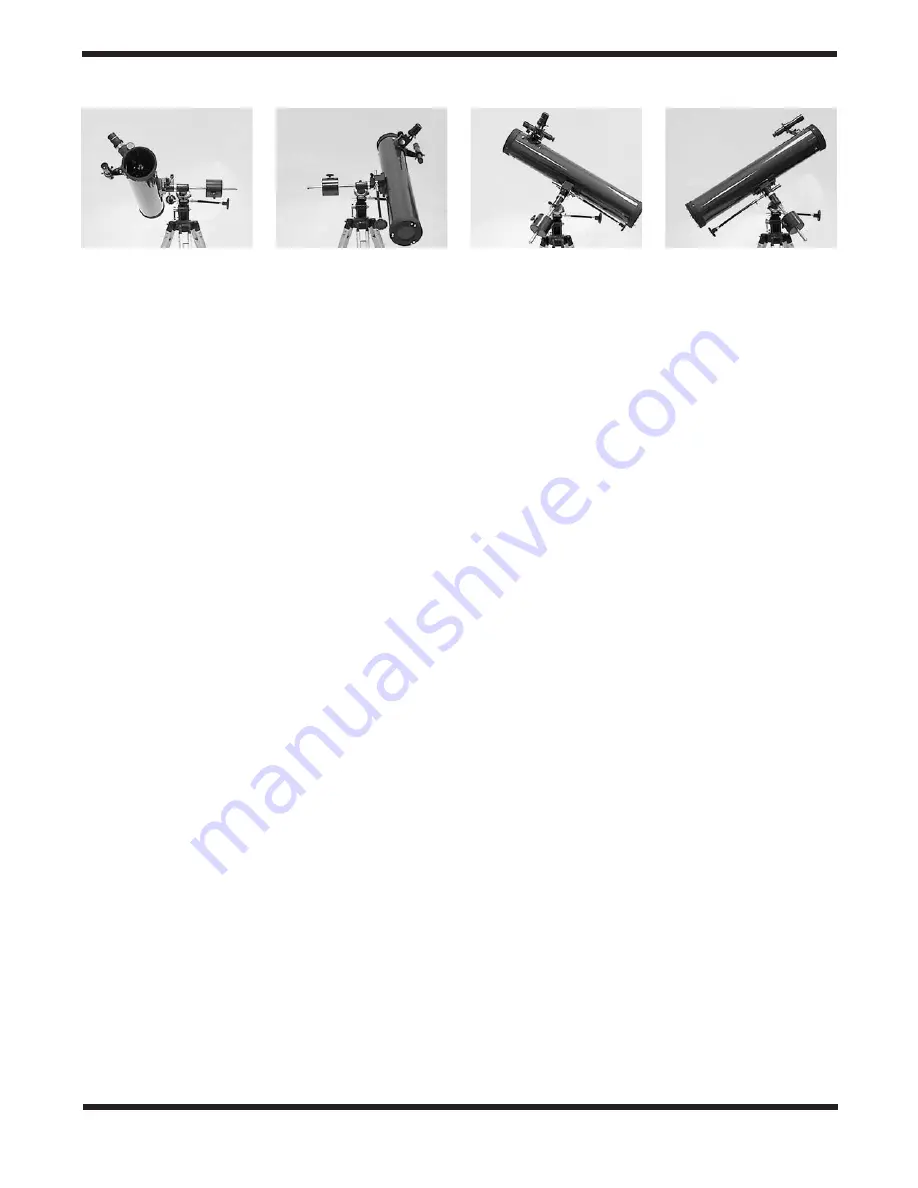
8
setting circle. Remember to use the upper set of numbers on
the R.A. setting circle. Retighten the lock knob.
Most setting circles are not accurate enough to put an object
dead-center in the telescope’s eyepiece, but they should
place the object somewhere within the field of view of the find-
er scope, assuming the equatorial mount is accurately polar
aligned. Use the slow-motion controls to center the object in
the finder scope, and it should appear in the telescope’s field
of view.
The R.A. setting circle must be re-calibrated every time you
wish to locate a new object. Do so by calibrating the setting
circle for the centered object before moving on to the next
one.
confused about Pointing the telescope?
Beginners occasionally experience some confusion about
how to point the telescope overhead or in other directions. In
Figure 1 the telescope is pointed north, as it would be during
polar alignment. The counterweight shaft is oriented down-
ward. But it will not look like that when the telescope is pointed
in other directions. Let’s say you want to view an object that is
directly overhead, at the zenith. How do you do it?
One thing you DO NOT do is make any adjustment to the
latitude adjustment t-bolt. That will nullify the mount’s polar
alignment. Remember, once the mount is polar aligned, the
telescope should be moved only on the R.A. and Dec. axes.
To point the scope overhead, first loosen the R.A. lock knob
and rotate the telescope on the R.A. axis until the counter-
weight shaft is horizontal (parallel to the ground). Then loosen
the Dec. lock knob and rotate the telescope until it is pointing
straight overhead. The counterweight shaft is still horizontal.
Then retighten both lock knobs.
Similarly, to point the telescope directly south, the counter-
weight shaft should again be horizontal. Then you simply
rotate the scope on the Dec. axis until it points in the south
direction.
What if you need to aim the telescope directly north, but at an
object that is nearer to the horizon than Polaris? You can’t do
it with the counterweight down as pictured in Figure 1. Again,
you have to rotate the scope in R.A. so the counterweight
shaft is positioned horizontally. Then rotate the scope in Dec.
so it points to where you want it near the horizon.
To point the telescope to the east or west, or in other direc-
tions, you rotate the telescope on its R.A. and Dec. axes.
Depending on the altitude of the object you want to observe,
the counterweight shaft will be oriented somewhere between
vertical and horizontal.
Figure 6 illustrates how the telescope will look pointed at the
four cardinal directions—north, south, east, and west
The key things to remember when pointing the telescope is
that a) you only move it in R.A. and Dec., not in azimuth or
latitude (altitude), and b) the counterweight and shaft will not
always appear as it does in Figure 1. In fact, it almost never
will!
6. using Your telescope
choosing an observing site
When selecting a location for observing, get as far away as
possible from direct artificial light such as street lights, porch
lights, and automobile headlights. The glare from these lights
will greatly impair your dark-adapted night vision. Set up on
a grass or dirt surface, not asphalt, because asphalt radiates
more heat. Heat disturbs the surrounding air and degrades
the images seen through the telescope. Avoid viewing over
rooftops and chimneys, as they often have warm air currents
rising from them. Similarly, avoid observing from indoors
through an open (or closed) window, because the tempera-
ture difference between the indoor and outdoor air will cause
image blurring and distortion.
If at all possible, escape the light-polluted city sky and head
for darker country skies. You’ll be amazed at how many more
stars and deep-sky objects are visible in a dark sky!
“seeing” and transparency
Atmospheric conditions vary significantly from night to night.
“Seeing” refers to the steadiness of the Earth’s atmosphere at
a given time. In conditions of poor seeing, atmospheric turbu-
lence causes objects viewed through the telescope to “boil”.
If, when you look up at the sky with just your eyes, the stars
are twinkling noticeably, the seeing is bad and you will be lim-
ited to viewing with low powers (bad seeing affects images at
high powers more severely). Planetary observing may also be
poor.
In conditions of good seeing, star twinkling is minimal and
images appear steady in the eyepiece. Seeing is best over-
head, worst at the horizon. Also, seeing generally gets better
after midnight, when much of the heat absorbed by the Earth
during the day has radiated off into space.
Figure 6.
This illustration show the telescope pointed in the the four cardinal directions (a) north, (b) south, (c) east, (d) west. Note that the
tripod and mount have not been moved; only the telescope tube has been moved on the R.A. and Dec. axes.
a
b
c
d















